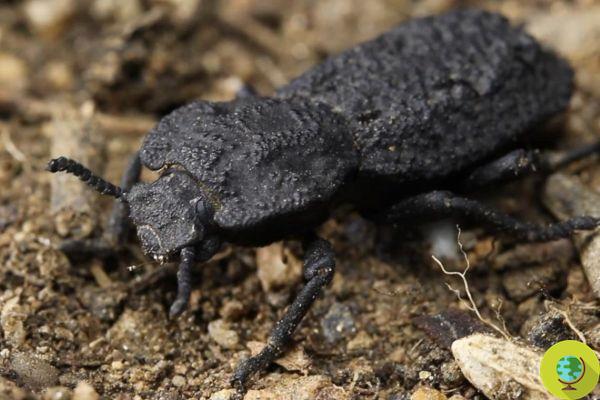
Native to Southern California, the armored beetle has an exoskeleton that is a real wonder of nature
He is about to end up run over, his mother saves himIt is called Phloeodes diabolicus, otherwise known as the armored beetle. A small but practically indestructible creature. A super hero of the beetle world. Scientists at the University of California at Irvine (UCI) revealed its surprising characteristics. Birds, lizards, and rodents often try to eat it, but rarely succeed. And even cars that accidentally crush him don't kill him.
Native to the desert habitats of southern California, the "diabolical" armored beetle has an exoskeleton that is a real wonder of nature: it is in fact the tougher, crush-resistant structure in the animal kingdom.
A creature to say the least suggestive to which the researchers wanted to recognize the extraordinary abilities. So they conducted a project to study the components and architectures responsible for their strength.
The cockroach's survival depends on two key factors: its ability to convincingly pretend to be dead and an exoskeleton that is one of the hardest and most crush-resistant structures known in the biological world. In a paper published in Nature, researchers studied its armor revealing the secrets that make it so indestructible.
"The armored beetle is a land beetle, so it's not light and fast, but it's more like a small tank," said lead author David Kisailus, professor of materials science and engineering. "This is his adaptation: he can't fly away, so he stands still and lets his specially designed armor endure the abuse until the predator gives up."
In its desert habitat in the southwestern United States, it can be found under rocks and in trees, squeezed between bark and trunk, another reason it must have tough, tough armor.
Lead author Jesus Rivera, a graduate student in Kisailus' lab during the project, discovered the existence of these organisms in 2015 during a visit to the renowned entomology museum at UC Riverside. From there his interest in beetles began.
By conducting a series of high-resolution microscopic and spectroscopic assessments, Rivera and Kisailus learned that the insect's secret lies in the material composition and architecture of its exoskeleton, particularly its elytra. In aerial beetles, the elytra are the front blades that open and close to protect the wings from bacteria and other external agents. The elytra of the armored beetle, on the other hand, have evolved to become one solid and protective shield.
Analysis by Kisailus and Rivera showed that the elytra are made up of layers of chitina, a fibrous material, and a protein matrix. In collaboration with a group led by Atsushi Arakaki and his graduate student Satoshi Murata, both of the Tokyo University of Agriculture and Technology, they examined the chemical composition of a lighter flying beetle's exoskeleton and compared it to that of their own. terrestrial subject. The outer layer of the armored devil beetle has a significantly higher protein concentration - about 10 percent more weight - which the researchers say contributes to the greater strength of the elytra.
Further microscopic examination revealed that the outer surfaces of these blades feature arrays of rod-like elements that scientists believe act as friction pads, providing additional resistance to skidding.
To further confirm their experimental observations, Rivera and co-authors Maryam Hosseini and David Restrepo, both of Pablo Zavattieri's laboratory at Purdue University, used 3D printing techniques to create your own structures with the same design. They have run tests that reveal that this solution provides maximum strength and durability.
According to Kisailus, the armored cockroach's exoskeleton may be inspiring to engineers around the world. In fact, by imitating its composition, resistant materials can be created.
"This study really connects the fields of biology, physics, mechanics and materials science towards engineering applications, which are not typically seen in research," said Kisailus.
Nature always has something to teach us.
Sources of reference: Nature, Uci
READ also:
- New scarab discovered: it bears the name of Leonardo DiCaprio
- Discovered a "bright" beetle in the rainforest of Peruù
- The beetle orientates itself by looking at the Milky Way


























